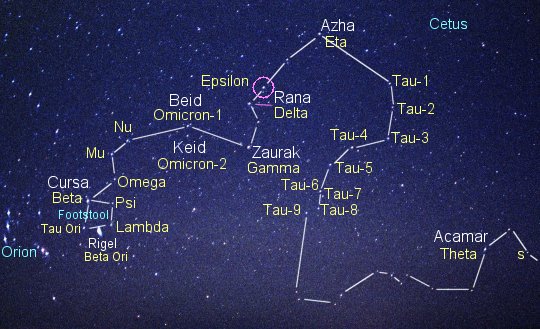 Epsilon Eridani is the closest star known to have a planet: and
maybe two of them. It is the only system that has both precise
Doppler data and long-baseline astrometric positional observations,
which combined yield the orbital tilt and the true planetary mass.
Given its closeness and the knowledge of where it is relative to
its star, the planet may become the first ever actually imaged.
Epsilon Eridani is the closest star known to have a planet: and
maybe two of them. It is the only system that has both precise
Doppler data and long-baseline astrometric positional observations,
which combined yield the orbital tilt and the true planetary mass.
Given its closeness and the knowledge of where it is relative to
its star, the planet may become the first ever actually imaged.
THE PLANET
The circle shows the location of the class K (K2) dwarf star
Epsilon Eridani (in the constellation Eridanus). At a distance of only 10.5 light years, the
star is the closest to the Sun for which an extrasolar planet is
known. With an average orbital radius 3.39 times that of the
distance between the Sun and Earth (the Astronomical Unit,
AU), 65% of the way from the Sun to Jupiter, the planet takes
6.85 years to make an orbit. Combination of stellar velocity and
positional measures of the star show the planet to have a mass 1.55
times that of Jupiter with an uncertainty of only 15 percent. The
orbital inclination of 30 degrees to the plane of the sky agrees
well with the inclination of a dusty circumstellar disk. Unlike
Jupiter, the planet is in a highly eccentric orbit that takes it
from as far as 5.8 AU from the star (just farther than Jupiter is
from the Sun) to as close as 1.1 AU. The planet will be farthest
from Epsilon Eridani proper, 1.7 seconds of arc, late in the year
2010, when we have the best hope of imaging it directly even though
it will be 20 million times fainter than the star. Slow changes in
the apparent orbit suggest another "Jupiter" with a period greater
than 50 years (which would place it at least 13 AU from the star).
|
 Epsilon Eridani is the closest star known to have a planet: and
maybe two of them. It is the only system that has both precise
Doppler data and long-baseline astrometric positional observations,
which combined yield the orbital tilt and the true planetary mass.
Given its closeness and the knowledge of where it is relative to
its star, the planet may become the first ever actually imaged.
Epsilon Eridani is the closest star known to have a planet: and
maybe two of them. It is the only system that has both precise
Doppler data and long-baseline astrometric positional observations,
which combined yield the orbital tilt and the true planetary mass.
Given its closeness and the knowledge of where it is relative to
its star, the planet may become the first ever actually imaged.